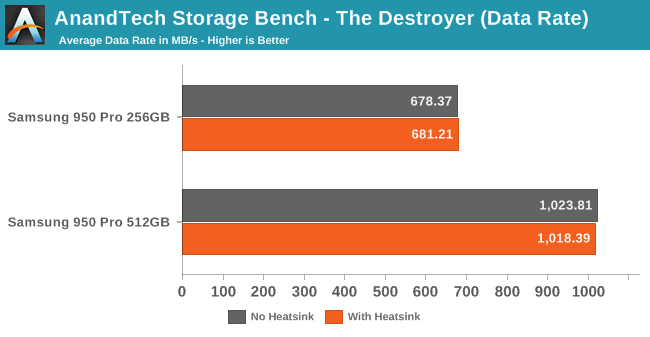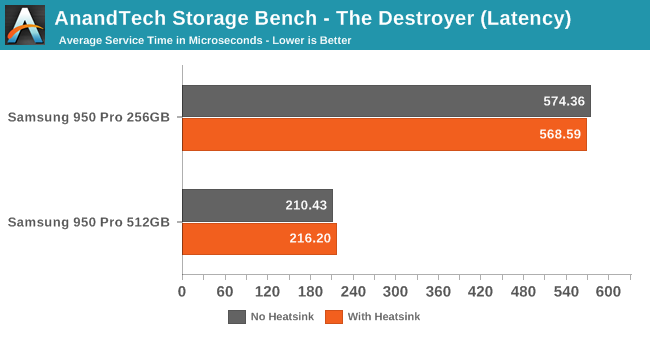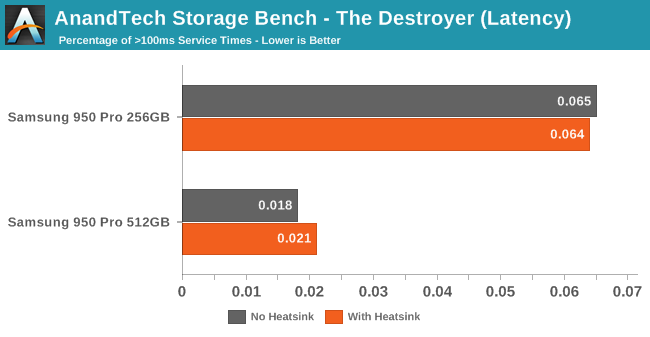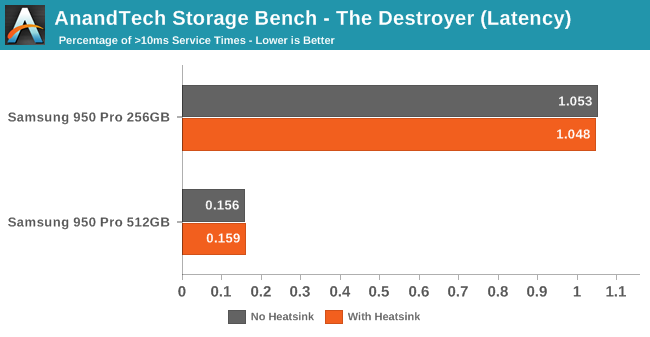The Angelbird Wings PX1 M.2 Adapter Review: Do M.2 SSDs Need Heatsinks?
by Billy Tallis on December 21, 2015 8:00 AM ESTAnandTech Storage Bench - The Destroyer
The Destroyer is an extremely long test replicating the access patterns of heavy desktop usage. A detailed breakdown can be found in this review. Like real-world usage and unlike our Iometer tests, the drives do get the occasional break that allows for some background garbage collection and flushing caches, but those idle times are limited to 25ms so that it doesn't take all week to run the test. Those pauses of up to 25ms are sufficient for the drive to complete a reasonable amount of background processing and return to idle, but they don't give the drive much time to cool off.


Average data rate on The Destroyer was essentially unchanged by the addition of the heatsink. The difference measured for average service time was slightly higher, but still insignificant. In both cases, the heatsink helped the 256GB drive and hurt the 512GB drive.


The frequency of latency outliers was also subject to some variation between runs, but its hard to attribute it to the influence of the heatsink since the effect was in the opposite direction for the two drives. With or without the heatsink the 950 Pro is posting great scores, and the 512GB drive outperforms the 256GB drive by a wide margin.










69 Comments
View All Comments
Billy Tallis - Monday, December 21, 2015 - link
Unfortunately, the only high-quality thermometer I have is the temperature probe for the multimeter that was busy doing the power measurements. I'll be getting some kind of thermometer soon, and I'm open to suggestions of something with data logging capability. Otherwise I'll get a cheap IR thermometer and you'll have to be satisfied with just a few spot readings instead of the full graph we'd both rather see.defaultluser - Monday, December 21, 2015 - link
I wonder if you could compare the performance of this heatsink versus just pointing a quiet 80mm fan at the drive? More moving air can have the same effect as much larger surface area, especially if we're only talking about half a watt extra required to reach full performance.ronboberg - Monday, December 21, 2015 - link
So, basically they just need an extension cable/riser for the M.2 slot (they can do it for normal pci-e slot, these are basically the same thing but smaller) so you can relocate the drive in a normal drive bay to keep it cooled off. Or if they started out with something like a real cable going to a slightly modified M.2 connector that would be purposed for just drives on the board in the first place they could make normal 2.5" size drives with the new connector, 2TB+, and all the advantages that goes with being bigger and able to be placed like a normal drive. If you don't have the space, the small boards could still have the universal M.2 slot they have now for the bubblegum stick size drives but would just have to put up with the heat.extide - Monday, December 21, 2015 - link
We already have what you are asking for: U.2tipoo - Monday, December 21, 2015 - link
I wonder how this compares to just slapping these on the relevant chipshttp://www.newegg.com/Product/Product.aspx?Item=N8...
Zak - Monday, December 21, 2015 - link
As few posters mentioned already: there is no room for even the tiniest heatsink.MrSpadge - Monday, December 21, 2015 - link
Of course there is enough space: the chip packages themselves. It won't work in a laptop, but for a desktop some simple small memory heatsinks should do the trick just as well. for 5$ (aluminum is sufficient instead of copper) instad of 75$. And never mind if the heat sink overlaps the chips a bit, just make sure it doesn't short anything on the mainboard (use some insulation tape as needed).tipoo - Monday, December 21, 2015 - link
Final words page, should the with and without heatsinks be flipped? If it was thermally shackled, should the higher bar not be for the one *with* the heatsink and not without?http://images.anandtech.com/graphs/graph9856/79399...
tipoo - Monday, December 21, 2015 - link
*for the 512GB drive at least, the 256 seems rightThe_Assimilator - Monday, December 21, 2015 - link
I think you are correct, I also noticed it and had a "huh, WTF?" moment.